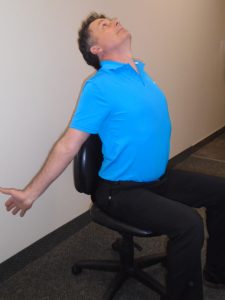[vc_row full_width=”stretch_row” css=”.vc_custom_1554563354559{padding-top: 10px !important;padding-bottom: 10px !important;background-color: #3853a4 !important;}”][vc_column][vc_row_inner el_class=”force-container”][vc_column_inner][vc_custom_heading text=”Office/Work Tips” font_container=”tag:h2|font_size:35|text_align:left|color:%23ffffff” google_fonts=”font_family:Roboto%3A100%2C100italic%2C300%2C300italic%2Cregular%2Citalic%2C500%2C500italic%2C700%2C700italic%2C900%2C900italic|font_style:300%20light%20regular%3A300%3Anormal” css=”.vc_custom_1554564739685{margin-top: -20px !important;}”][/vc_column_inner][/vc_row_inner][/vc_column][/vc_row][vc_row el_class=”force-container” css=”.vc_custom_1465330869237{padding-top: 40px !important;padding-bottom: 40px !important;}”][vc_column][vc_column_text]
Sitting all day is tough. It is critical to set up your workstation to limit the strain on your body. Take as many micro and macro breaks as you can. If your job involves sitting all day, a walking program is critical for your health. A super mini, anti-computer stretch is called brueggers position.
| Things to Look For | Possible Solutions |
| Prolonged hunched or elevated shoulder while holding the phone |
|
| Elbows splayed out (shoulder abduction) |
|
| Raised or tensed shoulders |
|
| Twisting the head to the side |
|
| Elbow flexed for long periods using the telephone |
|
| Elbow or forearm resting for long periods on hard or sharp worksurface, chair armrests |
|
| Wrists bent to the sides when using side keys |
|
| Wrists bent back (extended) or forward (flexed) for prolonged periods |
|
| Hands held actively over the keyboard during keying pauses |
|
| Rapid, sustained, or prolonged keying |
|
| Forceful keying, key pounding |
|
| Significant amounts of hand stapling, punching, lifting, opening mail, or other forceful exertions, especially combined with awkward postures |
|
| Prolonged mouse use |
|
| Prolonged sitting, especially in only one posture |
|
| Lumbar back area not supported |
|
| Feet dangling, not well supported, or a posture which seems to put pressure on the backs of the thighs |
|
| Chair backrest not used for long periods |
|
| Twisted torso |
|
| Frequent or prolonged leaning or reaching |
|
| Working with one or both arms “reaching” toward a mouse or keyboard |
|
| Light sources that can be seen by the worker |
|
| Reflected glare on the screen |
|
| Too much contrast between screen and surroundings or document; worker feels relief when bright areas are shielded |
|
| Very bright ambient lighting (above 500 lux or 50 fc) or shadowed areas caused by over-illumination |
|
| Monitor closer than approximately 65 cm (25″) |
|
| Different viewed objects (screen, documents) at different distances from the eyes |
|
| Screen or documents not oriented perpendicular to the line of sight (tipped back slightly is even better) |
|
| Prolonged near focusing throughout the day with few far-focusing opportunities |
|
| Monitor image dim, fuzzy, flickery, small, or otherwise difficult to read |
|
| Use software to enlarge image |
|
| Forward head posture (peering) or squinting |
|
| Eyestrain complaints |
|
| Neck extended backwards, head tilted back, even slightly |
|
| Neck severely flexed (downward) |
|
[/vc_column_text][/vc_column][/vc_row]
